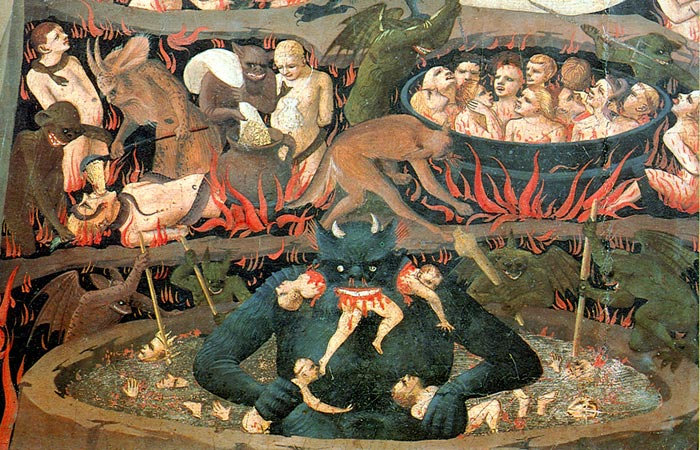In this essay, Ruby Nilsson explores trans theory, architecture, aesthetics, and political critique through the lens of Jack Halberstam’s concept of “unworlding.” Engaging with ‘anarchitecture,’ Philip Johnson’s fascist legacy, Björn Säfsten’s performance Haunted Desires (2025), and Henrik Olesen’s exhibition Food Chain incl. prehistoric animals (2025), she interrogates complicity, identity politics, fascism and the erasure of trans lives—particularly the lives of trans women. At its core, “Tens across the Un(der)world” is an urgent response to a world in collapse—an exorcism amid its ruins. It challenges us to ask: Does destruction pave way for a future beyond assimilation? Can solidarity exist beyond identity? And if so, how?
Exorcism is the practice of evicting malevolent entities from a person, or an area, that is believed to be haunted or possessed.1
✝
Wednesday afternoon. The sun filters through the venetian blinds, casting soft grey stripes inside the concrete brutalist auditorium at the south campus of University of Copenhagen. From my seat, I see eager, familiar faces: PhD lesbians, dark academia transsexuals, non-binary undergrads in statement outfits. “We’re shocked by the turnout!” say the organizers. Jack Halberstam is here to lecture on Unworlding: Architecture after Everything.
✝✝
Halberstam’s keynote repurposes the concept ‘anarchitecture’ in favour of trans theory. ‘Anarchitecture’ was coined by the New York-based movement from the 1970’s with the same name, a movement led by architect Gordon Matta-Clark (1943-1978) who set out to dismantle and unbuild the discipline of architecture, which he pursued via a series works such as Fake Estates and “building cuts”, where he rearranged abandoned buildings by cutting them in half, inserting different types of holes and constructing absences in them.2
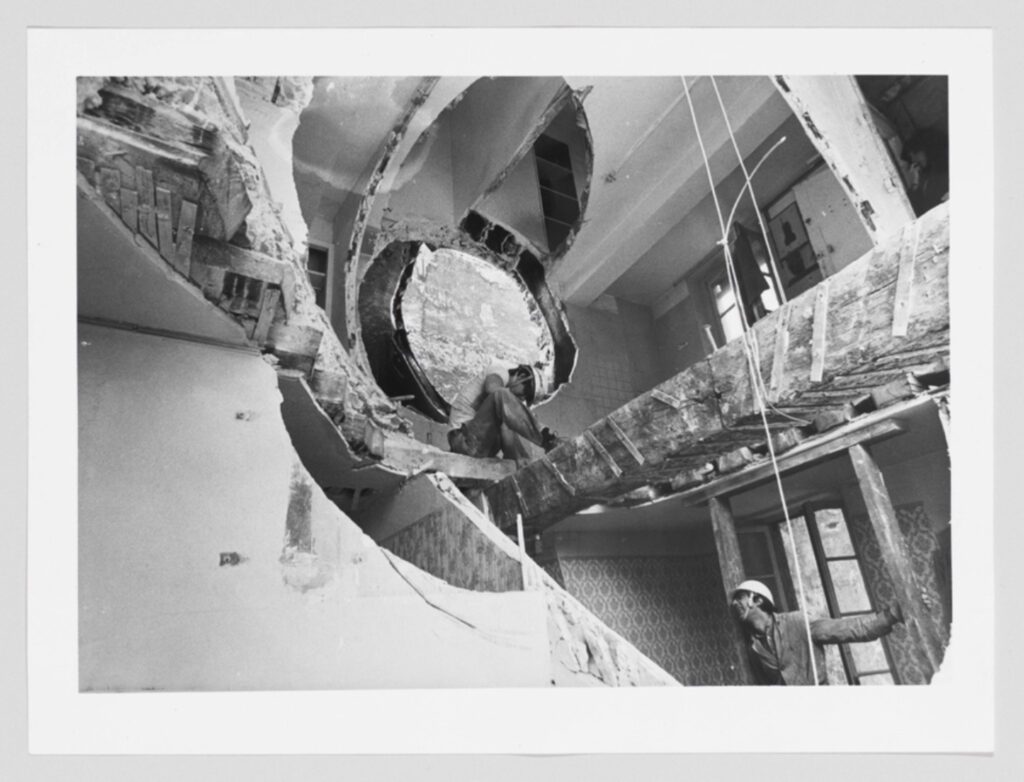
Halberstam is interested in the ways ‘anarchitecture’ can hold as a non-identitarian foundation for ‘trans worlding’, and how it as a concept can activate a notion of ‘world-making’ without fixing the old ones. Since fixing them would, according to Halberstam, only reinscribe transness as a problem to be solved, as a bug in the machine, an apparition in the perfect shell of binary sex. This is where the term ‘unworlding’ comes in as Halberstam’s own take on it, a way of transing anarchitecture; transness as the refusal to rebuild, heal and reiterate the world that has been. Following Eva Hayward’s notion of ‘the cut’ as it’s developed in her essay More Lessons from a Starfish: Prefixal Flesh and Transspeciated Selves (2008), Halberstam understands the bodily materiality of subtraction, the creation of cuts, voids and absences in the sexed body, as ‘anarchitectural corporeality’, in other words, trans materialises itself as an embodied practice of unworlding.
Worlds break and we must resist the urge to put it back together, to pull the shards into passable shapes, to form facsimiles of unbroken life. Once in the heart of the demolition, we see that the future is not ours—we cannot take it, dream it, buy it, or occupy it. It is now, it is here, and it is over.3
In the lecture, a subplot slowly unfolds via a detailed account of the life of the American “architect” Philip Johnson (1906-2005): a story about a gay man who, without an architectural degree, ended up as the founding head of the Department of Architecture at MoMa, reshaping mid-century modernism and designing the infamous Trump Castle (a project of a 60-story luxury residential complex, which was declared the work of a madman and was never built).4 All of this was made possible because Johnson was loaded with a huge amount of inherited wealth. He saw that architecture required no education, only capital. The capital, Johnson realised, was best invested and accumulated through real estate, which in the 70’s boomed on the capitalist invention of personal mortgages—selling people loans for property they would never truly own. Did someone say psyop?
Johnson, who is most known for “his” design of The Glass House (1949) – a design he mainly stole from Mies van der Rohe who couldn’t afford building his house as fast as Johnson – put his own flair to the design: a large chimney, which also housed a hidden bathroom. Everything else was visible to the outside eye. Why a large chimney, one may ask? To pay homage to the time he saw Hitler burn Jewish villages to the ground.

✝✝✝
The real story of Johnson is that he was a gay man who also openly aspired to become “America’s Hitler”, something often disregarded as an honest mistake, a stroke of innocent insanity. Because the man was after all a patron of the arts, hosting parties with people like Andy Warhol and most importantly, he was gay.5
Here, by casting Johnson as the antagonist of anarchitecture, Halberstam unravels a dark background to his project, demonstrating how and why identity politics easily fails, why LGBT-coalitions sometimes do more harm than good and why conceptual frameworks sometimes must be sought elsewhere than from within identitarian alliances (as they historically have created a nightmarish situation of erasure and invisibility for certain parts of the ‘identity conglomerate’, the most prominent example being the systematic erasure of trans life and trans rights, consistently overshadowed and deprioritised in favour of rights based on sexual orientation: same sex marriage, rights to surrogacy, adoption and so on).
The Trump administration has erased references to transgender people from New York’s Stonewall National Monument website. On the National Park Service website, the acronym LGBTQ+ has been shortened to LGB, standing for lesbian, gay and bisexual. Other government websites have also been changed after President Donald Trump signed an order recognising two sexes only – male and female – on his first day in office.6
✝✝✝✝
Wednesday night. I lie in bed and close my eyes, haunted by the image of Johnson as Trump’s devoted lapdog and ultimate pick-me f*ggot, enthroned on a tiny mid-century pouffe in Manhattan’s unbuilt vampire castle, sipping Aryan twink blood as the world burns. After a while, I manage to fall asleep despite the fact that my vision holds more true than false.
I soon wake up to the gruelling presence of an entity that has taken my gut into its possession again. I text a friend: “I put the omen in women”. I look over to my right: there, my dog, still asleep on her new bed which she desecrated last night by peeing on it. I don’t want to wake the demon yet, it’s too early I tell myself.
I pet her and scroll to keep the demon at bay for a few more hours, both the one within me as the one beside me. A meme catches my eye. In the background is a building in flames, only ruins left. In front of it, a woman stands in butt enhancing shorts, swinging her right leg which is fastened to a cable machine that has been cropped out of the image. Body, scorched ruins. Scorched ruins, body. If life gives you scraps, make contraptions out of it. After all, everything is complicit with everything.
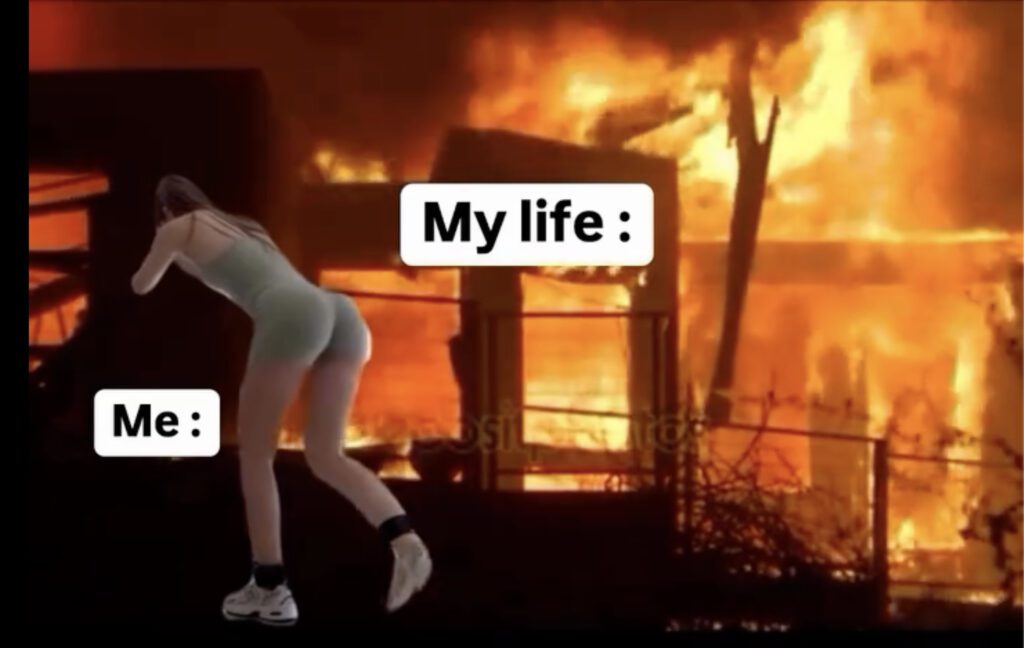
✝✝✝✝✝
Unworlding means to be unwilling to rebuild the old world, yet forced to use it, to dwell in its toxic and inflammatory effects. Halberstam never uses the exact word ‘complicit’ to describe how unworlding relates to the term ‘world’, but there are strong parallels between unworlding and complicity: “a mode of self-understanding that guides action, evading the social hierarchies demanded by a claim to innocence, uprooting (neo)liberal attitudes that look to evade friction by doling out punishment and exclusion” as Mijke van der Drift and Nat Raha put it in They Would Plant the Rose Garden Themselves: Femme, Complicity, Solidarity, and the Rewiring of the Sensuous (2024), an essay on trans femme solidarity featured in their new book Trans Femme Futures (2024).7
As the world is being shattered to pieces by geno- and geocides, parts of them directly tethered to the annihilation of trans women (of color), I wonder what a non-identitarian project means for the solidarity with those already at the bottom of this vexed battlefield of the world’s war on trans life? How can we keep these ‘chains of identity’ and difference in mind, while doing away with them? What would such a “holding environment” look like “for a more survivable life”?8 Because I know, we must see beyond category, beyond identity. We must trans (verb) trans (noun) ad infinitum. After this text is published, I suspect people will tell me that the question I pose is wrong, that it’s formulated from a faulty angle. Yet I cannot see or feel beyond my suspicion, this angle of life, which is the angle I am complicit with, the angle that makes up its own un(der)world of Identity: trans womanhood.
We are living in the global era of trans, a shortened or prefixal version of the word transgender. As an umbrella promoted by the global North, trans is a hyper-inclusive category under which a constellation of gender identities and styles are meant to find their home. As a prefix, trans- is also a kind of boundary-crossing energy, a refusal to be contained by binaries, and attachable to nearly anything: not just people around the world in countless cultures and languages, but also animals, molecules of animate matter, or digital technology. Trans is caught between describing a small minority of people and naming something hyper-modern about how the world works. But trans, as the inheritor of transgender, is also uniquely premised on the distortion and domestication of trans femininity. Prefixal trans politics promise a queer utopia of gender in which everyone else is set free by getting rid of a backward trans womanhood. This is an origin story that is rarely told.9
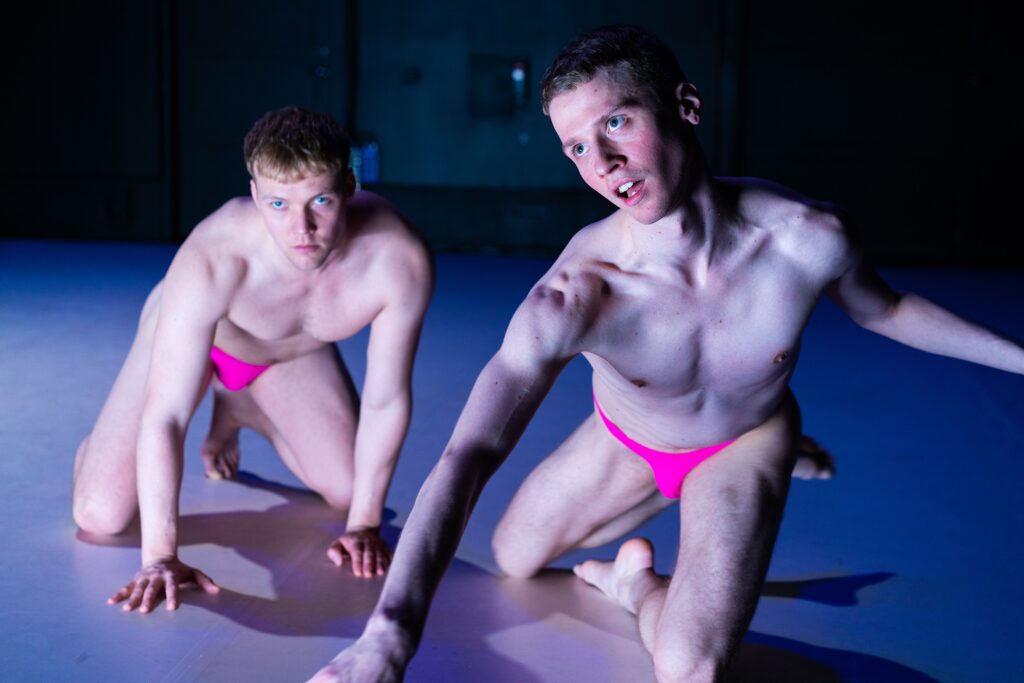
✝✝✝✝✝✝
It’s Friday. I have been invited to an “expert visit” before the showing of Björn Säfsten’s Haunted Desires at Inkonst in Malmö to present my practice and upcoming projects. After my presentation, I am dreaded by the fact that I needed to out myself in a clumsy way in front of strangers, all while trying to mask the pain from what I assume to be a growing ‘side wound’ in my intestines. Girlhood is a spectrum spectre.
After a while, a programmer for a festival in New York approaches me. I have a beer even though I shouldn’t and regret it immediately. We chat about my work, and the situation in the States. He mumbles something about how “New York will always be New York”, as if to distance himself from what’s going on in the rest of the country. I tell him it’s getting worse here as well. That this life is made less inhabitable for each day that passes. “I can’t even imagine”, he says while looking away. I smile, look at him and say “Well, neither can I, but I have to.” He doesn’t look back at me, because that would mean looking into a world where his New York isn’t New York anymore.
✝✝✝✝✝✝✝
Notes from watching Haunted Desires 7th of March 2025:
Three white male dancers, mid-20s to mid-30s (?), emerge from behind sheer fabric—like sleek venetian blinds of a brutalist building, placed in the left corner on the back of the stage.
Pink thongs. Pink triangles. Intentional?
Apathetic faces.
Movements slow, robotic.
What are they trying to depict?
The brief-let says apps and algorithms. New scene.
Two dancers reenact a hookup.
All dialogue is prompted by a voiceover. Lip-synced.
Still, movements have a digital feeling to them.
Sounds like a bad porno if I close my eyes.
One says: I don’t use the word queer.
I zone out.
New scene.
The third dancer enters from behind the blinds.
A monologue.
Machinic voice.
But the source is real.
Thenmilk. Bottles of it. Spilled milk.
They spit out the milk.
White on white.
Light changes.
Neon.
Reminds me of Spring Breakers.
“Twink Breakers”.
Milk falls from the ceiling.
A bukkake without jouissance, unless jouissance is a violent status quo.
They laugh.
I don’t.
Lights down.
Milk.10
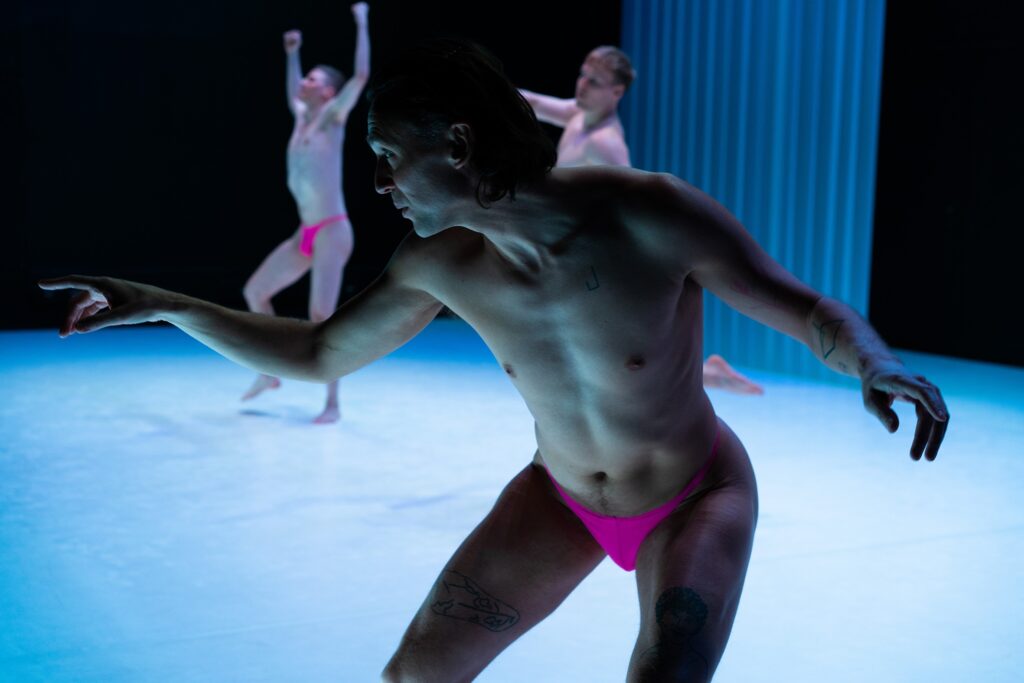
✝✝✝✝✝✝✝✝
“The thing that you desire, perhaps you must become?” Säfsten allegedly poses on Inkonst’s page about Haunted Desires, proposing a critical inquiry into the gay desire machine. But the work, built on autobiographical material produced with three fit, white, male dancers about what they face on dating apps and social media platforms, loses itself to self-disciplining the algorithmic, hyper-mediatized gay (sex/love) life into choreographic perfection, showing us that it excels in picking up the shards of the shattered screen-world that haunts it, building it into a new shape, a desire-bukkake for the machine.
I leave the performance feeling like I just watched an hour of high-end gay porn featuring aryan humanoids, drenched in strange milk propaganda. Sure, it’s chic, it’s elevated and very calculated, and if this was Säfsten’s intention, to become the equilibrium of the algorithm, then he succeeded.
The U.S.-based white supremacist movement that calls itself the “alt-right” has recently embraced milk as a symbol. In February, shirtless neo-Nazi protesters danced outside Shia LaBeouf’s anti-Trump art installation, He Will Not Divide Us, chugging gallons of milk that dripped messily down their chins.11
But if the algorithm is haunted of its own accord, overwhelmed by itself, becoming a contraption of slop and absurdity, then Säfsten’s well-oiled dramaturgy of milk twinks is haunted by the seething lack of its own contraptions besides the contraption of the machine it so perfectly mimics. In a time of rampaging neo-nazi conservatism, the tongue-in-cheek assemblages of the pink-triangle-as-thong and the milk-bukkake fall short, as they strike me as nothing but empty, detached poses. A complicity without criticality. Because how is the triangle and algorithm connected via the gay desiring bodies? What is the algorithm’s relationship to fascism? How does the deep oceanic ‘danse macabre’ of images, surveillance, colonialism and capital actually affect and render the autobiographical material the dancers have produced? How is gay desire complicit with these connections and assemblages? Such prompts could potentially sketch out a different, deeper choreographic histories to a ‘haunted desire’. Although, I must confess: I’m not an expert: I’m not gay, but a rare type of ‘ex-gay’ one could say. Säfsten is quite explicit about how the work addresses its audience: it’s a work for other gays, so my spectatorship take place outside, in the ruins of faggotry, via a twink gaze that has been unborn.
✝✝✝✝✝✝✝✝✝
Saturday afternoon. I’m standing in a wasteland of papier mâché crocodiles, plaster, twigs, cement, screws glued to canvases, castings of milk cartons and photographs of raw meat glued to plastic sheets, mixed with a vast expose of essays and other textual material, sculptural boxes––containing pictures and books––screwed to the wall, next to large wall-hanged collages that sketch out historical genealogies of homosexuality and the punishments it has faced over the course of half a millennia.
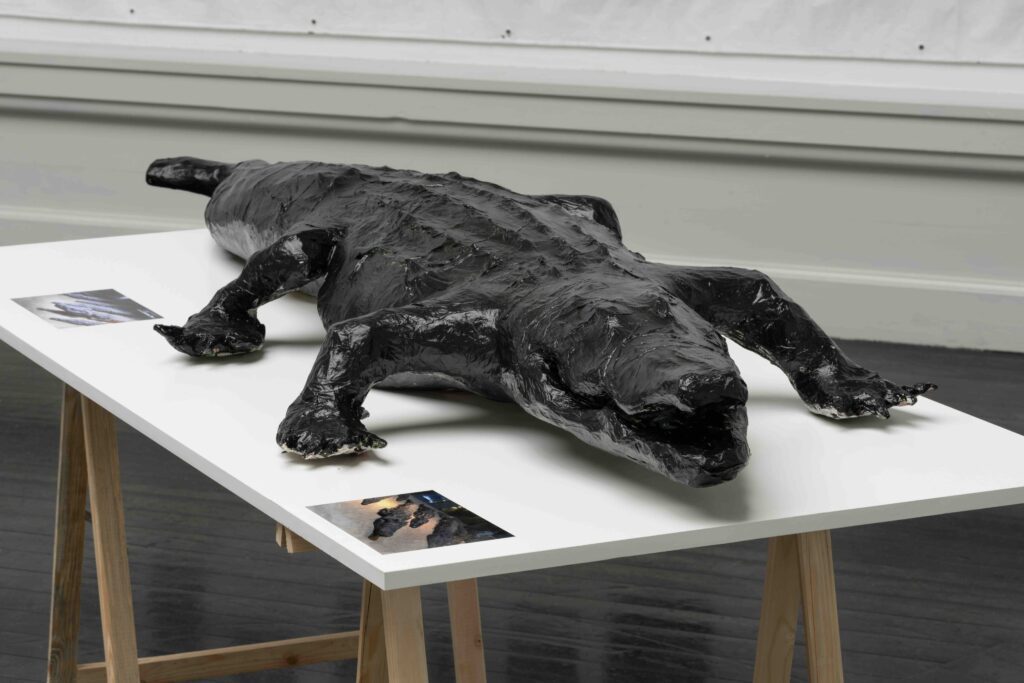
I’m at Henrik Olesen’s Food chain incl. prehistoric animals at Den Frie Udstillingsbygning in Copenhagen, open until the 20th of April. Here, the primal, the intestinal, the sexual and the social are exorcised and spit out like various vomits of dark information and graphic imagery, together positioning themselves as an accumulation of aesthetic surplus value of the world’s different ‘food chains’ — a term which evokes a feeling of cycles and hierarchies, ecological as social, capitalist as primal. In the midst of this accumulation is the prosecution against homosexuals.
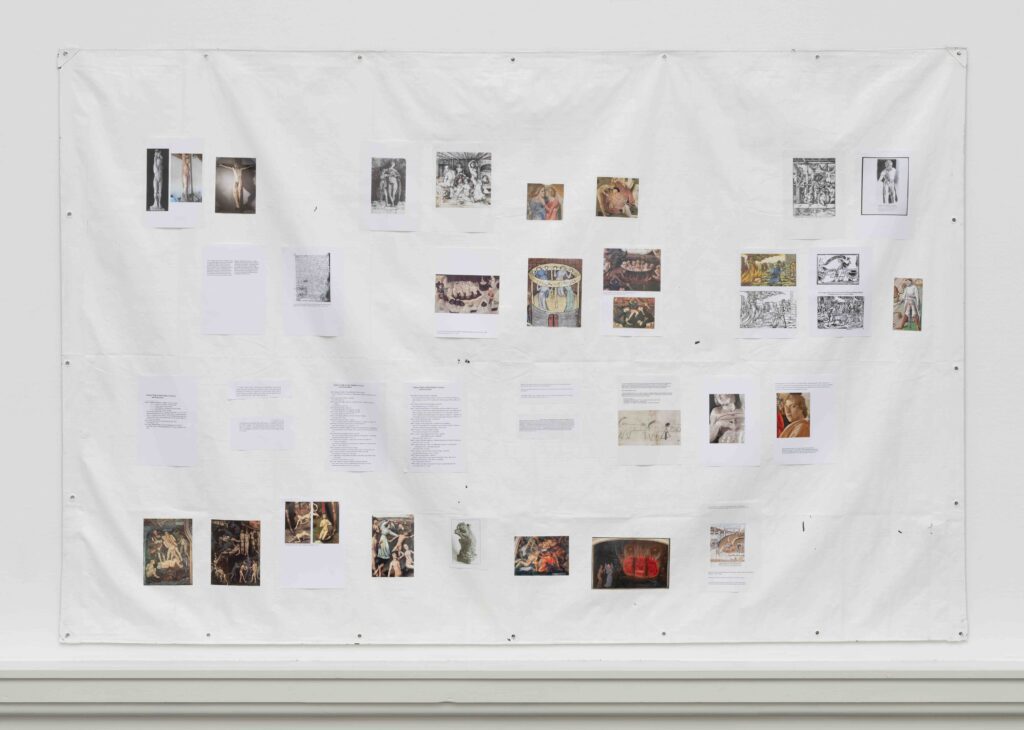
If “heterosexuality is the opiate of the masses”[xi], then homosexuality is like an afterglow mixed with a comedown: a rollercoaster of euphoria and nausea, excitement and anxiousness, clarity and delirium. Olesen’s works “link digestion and consumption, ingestion and excretion, to the formation and destruction of the self, to form-making and formlessness” writes Den Frie’s curator Marianne Torp about the space that showcases Olesen’s organ paintings (2020-2025) in the hand-out to the exhibition. I would like to add ‘sex’ and ‘punishment’ to her list, to describe the exhibition’s “formation and destruction” as a (w)hole. The artist manages to slit open the dark genealogies of homosexuality like a piece of alien intestine, poking at its inflamed appendices, nailing them to the walls of Den Frie as testimonies to the antagonism queer life has faced, and still faces. The works are possessed by a unique sense of humor that unfold not only thanks to Olesen’s cunning compositions, but by history’s own cruel and absurd digestion of homosexuality: witch hunts, incarceration, torture, mutilation, dismemberment, death and more.
What Olesen shows us is what one might call a ‘haunted desire’, as it is a contraption––unwhole, complicated, cumbersome, sublime at times and sometimes so vast in its scope that it becomes underdetermined, weird, formless and uncanny. In this haunting, I for a moment reconnect with my transsexed life as a former f-slur, my inner anarchitecture of a past life that has been cut away. And for that I am grateful.
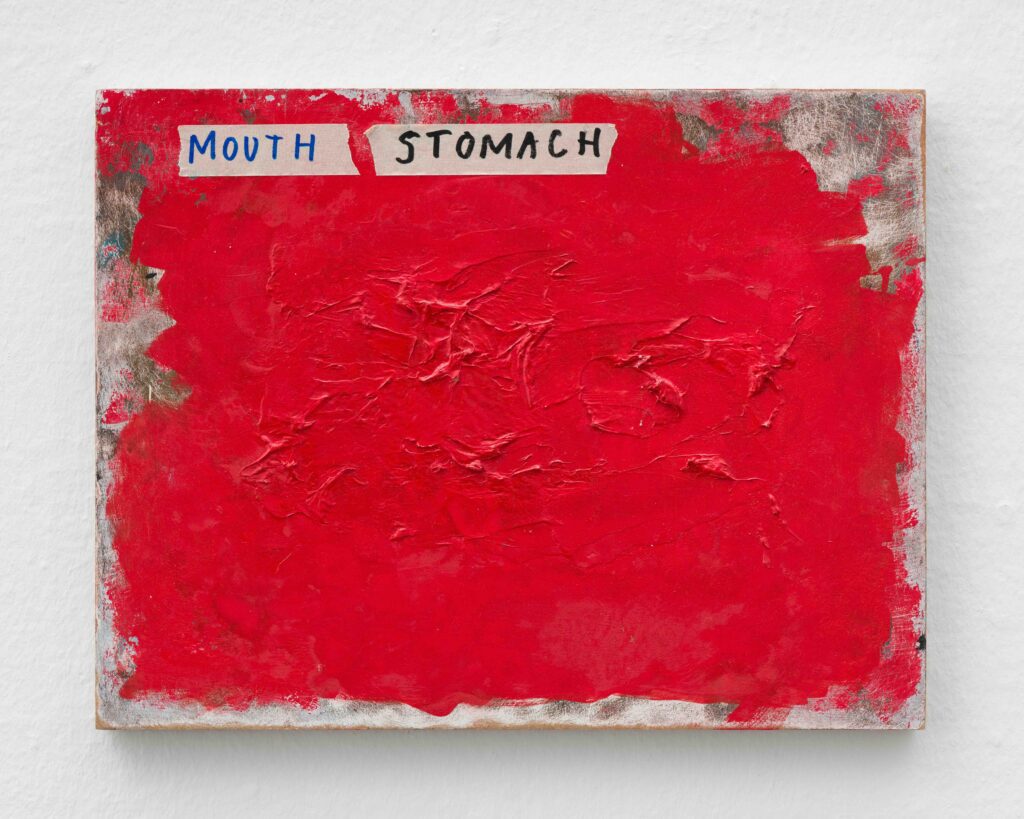
✝✝✝✝✝✝✝✝✝✝
Sunday morning. I wake up still possessed by Olesen’s insanity. Although ‘insanity’ is a bad word and needs rephrasing. I want to cross it from the page and not show you my improper writing, but I don’t have time to scrap now. My dog has entered beast mode again. She’s in heat, which makes her more feral than usual. Her whimpering gets mixed with loud sounds from my colon, forming a ghoulish chorus that puts me under an aching spell. I surrender to her and the pain. For a moment I play with the (im)possibility that what I’m possessed by might not be an illness, but Rosemary’s baby. In a fucked up way, this delusion makes me smile.
I take a walk to make both of them calm down. My dog’s name is Lucy, I often joke about it being short for Lucifer, which has become somewhat of a half-truth these days. She looks like the hellhounds of medieval church paintings. In her world, which is another kind of un(der)world akin to mine, excretion smells like fresh buns. Trash tastes like fine dining. And rats, she is obsessed with rats.
As we walk down the street I notice people looking, first at me, then at Lucy, then at the leash which has fallen out of my grip, and then Lucy again, who is now making a run for the park a block away. I feel eyes piercing in my neck, clocking us for what we truly are: the plague.
In my headphones a song by Arca comes on, her vocals glitched and cut up like the monologue from Haunted Desires, but conveying a message much more out there like one of Olesen’s paintings, “THIS IS MY ORGANS”. As I run after Lucy, I pass by a demolished building and notice one of the ruins has a large sticker on it. “Sapphics for Socialism” it says. I imagine what my sticker would look like. Perhaps “Dolls for Demolition.”
I am not naive. I know that not everyone will join us as the world collapses in on itself. We will not overcome. Most people will shut their venetian blinds from the sight of our life-ruins in favour of the warm embrace of their own Glass House. But for those of you who will stand and fight against a future where we don’t exist[xii], now is the time to act. But how? Well, if non-identitarian alliances are to hold true, it’s time to be the one to throw the first stone. Protect the dolls. And on our command:
”CH-CH-CHASERS TO THE FRRRON-T.”[xiii]
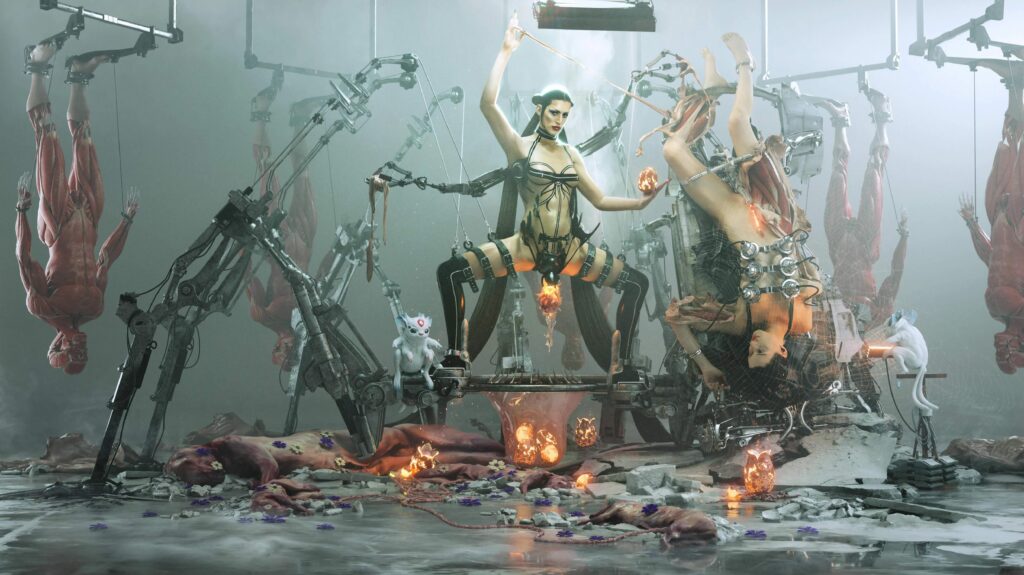
Cover photo for Arca’s KICK ii (2021)
Ruby Nilsson (b.1993) is an artist and writer based in Copenhagen/Malmø, educated at The Royal Danish Academy of Fine Arts (DK). Her work oscillates between the fields of visual- and performing arts, often finding its final form in large-scale scenic productions.
She is the creator, editor and curator of the artistic center C.U.T.S, (Center of Unseen Trans Survival) and is currently producing her upcoming performance feign. In addition to her artistic work, she lectures in ‘Text as Artistic Medium’, a summer course at the Royal Swedish Institute of Art.
Jack Halberstam: Unworlding: Anarchitecture after Everything, KUA Copenhagen
5.03.25
Keynote given at KUA the 5th of March.
Funded by the Department of Arts and Cultural Studies Art and Health and Art and Earth research clusters at the University of Copenhagen, and organized in collaboration with Christa Holm Vogelius and IngerGen.
Björn Säfsten: Haunted Desires, Inkonst (Malmø)
7.3.25
Choreography: Björn Säfsten, in close collaboration with the dancers
Script: Björn Säfsten and Pär Andersson
Dance: Pär Andersson, Philip Berlin and Sam Huczkowski
Music: Victor Saiz
Light design: Jonatan Winbo
Set design: Björn Säfsten and Jonatan Winbo
Costume: Björn Säfsten
Construction and manufacturing technician, Dansens Hus: Johannes Fäst
Dramaturgy: Kristina Hagström-Ståhl
Photography: Märta Thisner
Voice actors: Klas Lagerlund och Dan Mclellan
Audio editor: Joakim Lundgren
Intimacy coordinator: Sara Arrhusius
Production: Nordberg Movement
Co-production: Inkonst
With support from: The Swedish Arts Council, The Swedish Arts Grants Committee, The City of Stockholm, and Region Stockholm
Henrik Olesen: Food chain incl. prehistoric animals
22.02. – 20.04.25
Curators: Marianne Torp, Magnus Thor Clausen
Chief technician: Soren Fjeldsø
Installation: Lars Buchhardt, Peter Højbjerg
Texts: Magnus Thorø Clausen
Translation: René Lauritsen
Proofreading: Louise Urth Olsen
Graphic design: Olga Bramsen
Supported by: Statens Kunstfond, Augustinus Fonden, Det Obelske Familiefond, Aage og Johanne Louis-Hansens FondGoethe-Institut
- This ‘eviction’ is not religiously or spiritually performed in the name of practices such as let’s say “conversion therapy” or the Catholic church, although they serve this piece as cruel backdrops, hence the blasphemous use of the Christian cross before each paragraph. This work is, put in the simplest way, a collection of ten notes, exorcised around the concept of ‘unworlding’ and the different identity-entities that might haunt it. It also contains transcribed parts of a lecture, reviews of a performance and an exhibition. Lastly but not least, this text is an attempt to exorcise my own ‘scrap parts’, summoning my sex(uality) as the text’s seething presence. ↩︎
- Artists such as Laurie Anderson, Tina Girouard, Carol Goodden, Suzanne Harris, Jene Highstein, Bernard Kirschenbaun, Richard Landry, and Richard Nonas are also counted as part of the Anarchitecture Group. For more information about the movement, see https://www.spatialagency.net/database/the.anarchitecture.group [accessed 2025-03-14] ↩︎
- Jack Halberstam, “Unworlding” in Journal of Architectural Education: Worlding. Energy. Transitions, (2024) 78 (2):272-276. ↩︎
- The Trump Castle was designed to mimic a medieval castle. The project included six cylindrical towers with crenellated tops, spires, and gold-leaf adornment, plus, at street level, a drawbridge and a moat. For further see https://www.theatlantic.com/magazine/archive/2019/04/trump-tower-real-estate-projects/583243/ [accessed 2025-03-14]. ↩︎
- “Touring Nazi-occupied Poland in 1939 with SS officers, attending a 1939 Hitler rally in Nuremberg, actively spying for the Nazis, designing a stage for the fascist radio personality Father Coughlin, and translating texts about Nazi political economy into English over a 20-year period were just a few of Philip Johnson’s so-called ‘mistakes’”. Quote from a review of Rachel Maddow’s Prequel: An American Fight Against Fascism (2024). Full review can be found here https://www.archpaper.com/2024/01/prequel-rachel-maddow-philip-johnsons-fascist-activity-general-public/ [accessed 2025-03-14] ↩︎
- BBC, full article: https://www.bbc.com/news/articles/cglywwn29n6o [accessed 2025-03-15] ↩︎
- Mijke van der Drift and Nat Raha, “They Would Plant the Rose Garden Themselves: Femme, Complicity, Solidarity, and the Rewiring of the Sensuous” in Social Text (2024) Vol 42 (3 (160)): 75–100. ↩︎
- The concept of a ‘holding environment’ in this case stems from Hil Malatino’s “Weathering: Slow Arts of Trans Endurance” in Texte zur Kunst: Trans Perspectives (2023), Issue 129. The text can be found here: https://www.textezurkunst.de/en/129/hil-malatino-weathering-slow-arts-of-trans-endurance/ [accessed 2025-03-14]. ↩︎
- Jules Gill-Peterson,“Femmes Against Trans” in A Short Story of Trans Misogyny (2022). ↩︎
- These notes are unedited, personal notes taken during the showing of Haunted Desires at Inkonst, Malmö the 7th of March 2025. The notes are in no way an objective summary of the performance and do not claim to explain it beyond the experience I had as a spectator. ↩︎
- From https://theconversation.com/milk-a-symbol-of-neo-nazi-hate-83292 [accessed 2025-03-14] ↩︎
